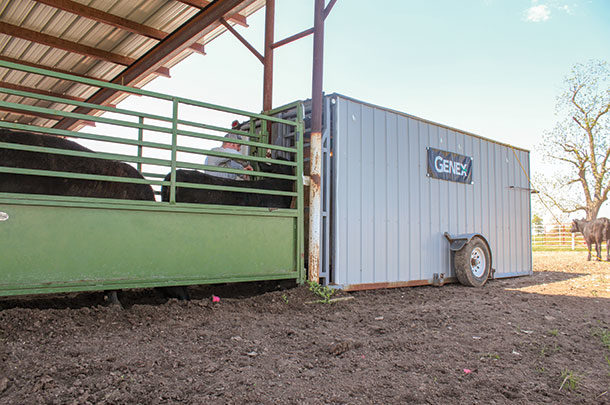Therefore, commercial cow-calf producers are looking for ways to add value to their operations. Often thought of only as an additional expense, implementing an artificial insemination (A.I.) program can help improve herd performance and lead to new avenues of income generation.
The value of proven genetics
The ability to use proven genetics at a reasonable cost is a huge reason to consider implementing A.I. At bull sales all over the country, bulls can be found that rank among the breed’s best for economically relevant traits such as calving ease, weaning weight, docility and marbling; however, it is nearly impossible to go to a bull sale and purchase those same breed-leading genetics with a high accuracy.
Many young sires with genomically enhanced expected progeny differences (EPDs) will boast an EPD profile with accuracies in the 0.30 to 0.40 range. The breed associations publish tables that outline the possible change in EPDs based on their accuracies. For instance, if purchasing an Angus bull with a CED of +10 and accuracy of .35, the table indicates his true EPD value falls anywhere from +3.3 to +16.7.
There have been horror stories told of this; a producer breeding a whole group of heifers to the new calving-ease herd sire found out the bull was not so calving-ease, or a producer bought a sire based on his outstanding growth numbers and then found reality to be less than expected.
A.I. allows producers to use the same level of genetics but with the additional benefit of being able to choose high-accuracy sires. According to the possible change table, a bull with the same CED of +10 and a 0.80 accuracy would have a true EPD value of +7.9 to +12.1. To most, that is a much more acceptable risk than the younger, unproven bull.
The value of more calves born earlier in the calving season
When implementing a synchronization and timed A.I. program, a pregnancy rate of approximately 60 percent is expected. This means six out of 10 females will be pregnant on the first day of the breeding season. This translates to more calves born earlier in the calving season.
At the University of Missouri Thompson Farm, calf crop distribution was analyzed for the first 46 days over 11 calving seasons. There were three years of natural-service breeding that included 526 calvings, two years of fixed-time A.I. with 585 calvings and five years of estrus detection and A.I. with 1,040 calvings. At day 16 of the calving season, 38 percent of natural-service cows had calved, 54 percent of the estrus-detection and A.I. cows had calved, and 62 percent of the fixed-time A.I. cows had calved.
By day 21 of the calving season, those numbers were 51 percent, 59 percent and 66 percent, respectively. Considering a calf gains 2 to 3 pounds per day, a calf born earlier in the calving season is worth significantly more when sold by the pound. In addition to heavier calves, a shortened calving season with a large number of calves sired by the same bull will result in a more uniform calf crop, which is also more attractive to buyers.
It is important to address a common concern among producers: “If I breed all my cows on the same day, won’t they calve on the same day?” The example above has already shown timed A.I. and synchronization can significantly tighten up the calving window, but University of Missouri data also showed cows that conceived on the same day to fixed-time A.I. gave birth to calves over a 16-day to 21-day period, with no more than 12 to 22 percent of calves born on a single day.
The value of replacements
It’s commonly known the most fertile heifers at breeding are the ones that exhibited their first estrus prior to breeding, and older heifers are more likely to have reached this milestone. It’s also known heifers that conceive and give birth earlier in their first calving season are more likely to calve early in subsequent calving seasons.
In a group of over 16,000 cattle managed at the USDA Meat Animal Research Center, heifers calving in the first 21 days, second 21 days and later had an average longevity of 8.2, 7.6 and 7.2 years, respectively. This proves early calving heifers have as much as a one-calf lifetime advantage compared to late-calving heifers. That doesn’t even take into consideration the additional weaning weight of their calves from being born earlier in the calving season.
In addition to the benefit of more replacement females born earlier in the calving season, A.I.-bred heifers can serve as a value-added income stream. In summarizing the sale reports for eight Missouri Show-Me-Select Replacement Heifer Sales held in spring and early fall 2018, 796 A.I.-bred heifers and 559 natural-service-bred heifers sold. The A.I.-bred heifers averaged $1,795, and the natural-service-bred heifers averaged $1,674. That is a $121 premium just for utilizing A.I.
Implementing an A.I. program is a management decision that brings additional monetary and labor inputs for a ranch, but it can also help drive value to the bottom line. Producers looking to add additional revenue during this time of price volatility should investigate the value of using proven genetics, having more calves born earlier in the calving season and added marketing opportunities A.I. can bring to the operation. ![]()
PHOTO: An A.I. program can help improve herd performance and lead to new avenues of income. Photo courtesy of Genex.

-
Sarah Thorson
- U.S. Beef Marketing and Education Manager
- Genex Beef
- Email Sarah Thorson











